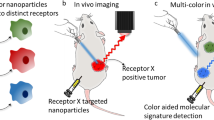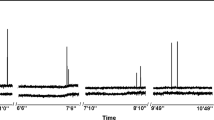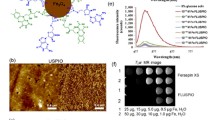Abstract
Renal cell carcinoma (RCC) remains one of the greatest challenges of urological oncology and is the third leading cause of death in genitourinary cancers. RCCs are highly vascularized and are amenable to antiangiogenic therapy. Endostatin (ES) is a fragment of collagen XVIII that possesses antiangiogenic activity. In this study, we examined the potential of erythrocyte PpIX fluorescence spectroscopy for monitoring the efficacy of antiangiogenic therapy in metastatic renal cell carcinoma (mRCC), using an orthotopic metastatic mouse model. Balb/C-bearing Renca cells were treated with NIH/3T3-LendSN cells. Lung weight, nodule area, microvascular area (MVA), and erythrocyte PpIX fluorescence were evaluated. Emission spectra were obtained by exciting the samples at 405 nm. There was a significant decrease in lung wet weight, lung nodule area and MVA in the treated group compared to the control group (P < 0.001). Significant differences in autofluorescence shape were observed in the 620–650 nm spectral region. The most intense fluorescence peak was observed at ∼632 nm. The autofluorescence of the control samples was about 53% higher than that of normal blood (P < 0.05). In the group treated with ES, the autofluorescence was about 54% lower than in the control group (P < 0.05). Fluorescence intensity was positively correlated with the nodule area (R 2 = 0.8859; P < 0.001) and MVA (R 2 = 0.9431; P < 0.001) in the ES-treated group. These results demonstrate that the spectroscopic analysis method allows a selective detection of tumor masses. This preliminary study suggests that PpIX fluorescence may be useful as a biomarker for antiangiogenic cancer therapy.





Similar content being viewed by others
References
Tonini T, Rossi F, Claudio PP (2003) Molecular basis of angiogenesis and cancer. Oncogene 22:6549–6556
Gupta K, Miller JD, Li JZ, Russell MW, Charbonneau C (2008) Epidemiologic and socioeconomic burden of metastatic renal cell carcinoma (mRCC): a literature review. Cancer Treat Rev 34:193–205
Chow WH, Devesa SS, Warren JL, Fraumeni JF Jr (1999) Rising incidence of renal cell cancer in the United States. JAMA 281:1628–1631
Hollingsworth JM, Miller DC, Daignault S, Hollenbeck BK (2007) Five-year survival after surgical treatment for kidney cancer: a population–based competing risk analysis. Cancer 109:1763–1768
Assouad J, Petcova B, Berna P, Dujon A, Foucault C, Riquet M (2007) Renal cell carcinoma metastases surgery: pathologic findings and prognostic factors. Ann Thorac Surg 84(4):1114–1120
Weiss L, Harlos JP, Torhost J, Gunthard B, Hartveit F, Svendsen E, Huang WL, Grundmann E, Eder M, Zwicknagl M, Cochrane HR, Stock D, Wright C, Horne CHW (1988) Metastatic patterns of renal carcinoma: an analysis of 687 necropsies. J Cancer Res Clin Oncol 114:605–612
Saitoh H (1981) Distant metastasis of renal adenocarcinoma. Cancer 48:1487–1491
Coutinho EL, Andrade LNS, Chammas R, Morganti L, Schor N, Bellini MH (2007) Anti-tumor effect of endostatin mediated by retroviral gene transfer in mice bearing renal cell carcinoma. FASEB J 21:3153–3161
Kerbel R, Folkman J (2002) Clinical translation of angiogenesis inhibitors. Nat Rev Cancer 2:727–739
Martin-Padura I, Bertolini F (2009) Circulating endothelial cells as biomarkers for angiogenesis in tumor progression. Front Biosci (Schol Ed) 1:304–318
Folkman J (2004) Endogenous angiogenesis inhibitors. APMIS 112:496–507
Boehm T, Folkman J, Browder T, O’Relly MS (1997) Antiangiogenic therapy of experimental cancer does not induce acquired drug resistance. Nature 390:404–407
O’Reilly MS, Boehm T, Shing Y, Fukai N, Vasios G, Lane WS, Flynn E, Birkhead JR, Olsen BR, Folkman J (1997) Endostatin: an endogenous inhibitor of angiogenesis and tumor growth. Cell 88:277–285
Kirsch M, Schackert G, Black PM (2000) Angiogenesis, metastasis, and endogenous inhibition. J Neuro-oncology 50:173–180
Te Velde EA, Vogten JM, Gebbink MFGB, Van Gorp JM, Voest EE, Rinkes IHMB (2002) Enhanced antitumour efficacy by combining conventional chemotherapy with angiostatin or endostatin in a liver metastasis model. Br J Surg 89:1302–1309
Schantz SP, Savage HE, Sacks P, Alfano RR (1997) Native cellular fluorescence and its application to cancer prevention. Environ Health Perspect 105(Suppl 4):941
Ramanujam N (2000) Fluorescence spectroscopy of neoplastic and non-neoplastic tissues. Neoplasia 2(1–2):89–117
Chang KS, Ina P, Marin N, Follen M, Richards-Kortum R (2005) Fluorescence spectroscopy as a diagnostic tool for detecting cervical pre-cancer. Gynecol Oncol 99:S61–S63
Vogeser M, Jacob K, Zachoval R (2000) Erythrocyte protoporphyrins in hepatitis C viral infection. Clin Biochem 33(5):387–391
Courrol LC, Silva FRO, Coutinho EL, Piccoli MF, Mansano RD, Vieira ND, Schor N, Bellini MH (2007) Study of blood porphyrin spectral profile for diagnosis of tumor progression. J Fluoresc 17(3):289–292
Bellini MH, Coutinho EL, Courrol LC, Silva FRO, Vieira ND, Schor N (2008) Correlation between autofluorescence intensity and tumor area in mice bearing renal cell carcinoma. J Fluoresc 18(6):1163–1168
Kusunoki Y, Imamura F, Uda H, Mano M, Horai T (2000) Early detection of lung cancer with laser-induced fluorescence endoscopy and spectrofluorometry. Chest 118:1776–1782
Tsai TM, Hong RL, Tsai JC (2004) Effect of 5-aminolevulinic acid-mediated photodynamic therapy on MCF-7 and MCF-7/ADR cells. Lasers Surg Med 34:64–72
Heyerdahl H, Wang I, Liu DL, Berg R, Andersson-Engels S, Peng Q, Moan J, Svanberg S, Svanberg K (1997) Pharmacokinetic studies on 5-aminolevulinic acid-induced protoporphyrin IX, accumulation in tumors and normal tissues. Cancer Lett 112:225–231
Malik Z, Kostenich G, Roitman L, Ehrenberg B, Orenstein A (1995) Topical application of 5-aminolevulinic acid, DMSO and EDTA: protoporphyrin IX accumulation in skin and tumors of mice. J Photochem Photobiol B 28:213–218
Van Der Breggen EWJ, Rem AI, Cristian MM, Yang CJ, Calhoun KH, Sterenborg HJCM, Motamedi M (1996) Spectroscopic detection of oral and skin tissue transformation in a model for squamous cell carcinoma: autofluorescence versus systemic aminolevulinic acid-induced fluorescence. IEEE J Sel Top Quantum Electron 2:997–1007
Moesta KT, Ebert B, Handke T, Nolte D, Nowak C, Haensch WE, Pandey RK, Dougherty TJ, Rinneberg H, Schlag PM (2001) Protoporphyrin IX occurs naturally in colorectal cancers and their metastases. Cancer Res 61:991–999
Tsuji T, Sasaki Y, Tanaka M, Hanabata N, Hada R, Munakata A (2002) Microvessel morphology and vascular endothelial growth factor expression in human colonic carcinoma with or without metastasis. Lab Invest 82:555–562
Hlatky L, Hahnfeldt P, Folkman J (2002) Clinical application of antiangiogenic therapy: microvessel density, what it does and doesn’t tell us. J Natl Cancer Inst 94:883–893
Acknowledgements
This study was supported by FAPESP [Process number: 07/54253-6] and CNPq [Process number: 481888/2008].
Author information
Authors and Affiliations
Corresponding author
Rights and permissions
About this article
Cite this article
de Góes Rocha, F.G., Chaves, K.C.B., Gomes, C.Z. et al. Erythrocyte Protoporphyrin Fluorescence as a Biomarker for Monitoring Antiangiogenic Cancer Therapy. J Fluoresc 20, 1225–1231 (2010). https://doi.org/10.1007/s10895-010-0672-7
Received:
Accepted:
Published:
Issue Date:
DOI: https://doi.org/10.1007/s10895-010-0672-7




